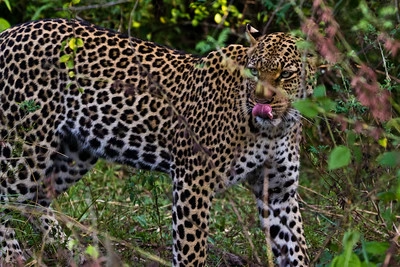Leopards in Uganda: Pian Upe Wildlife Reserve leopards-Leopard sightings Uganda-Big cats in Uganda-Uganda leopard conservation
A Guide to Spotting the Stealthy Predators 
Leopards, renowned for their elusive nature and stunning spotted coats, are among the most fascinating big cats in Uganda.
Known for their stealth, agility, and adaptability, leopards can be found in various habitats across the country. Whether you’re a wildlife enthusiast, photographer, or simply an admirer of the animal kingdom, encountering a leopard in the wild is a thrilling experience.
Where to Find Leopards in Uganda
Leopards are widespread across Uganda’s protected areas, thriving in savannahs, forests, and rocky terrains. Below are the top locations to spot leopards:
1. Queen Elizabeth National Park
The park’s diverse ecosystems, from savannahs to riverine forests, make it a hotspot for leopards.
The Ishasha sector of the park is famous for its tree-climbing lions, but leopards are also often seen lounging in trees or prowling through the thickets.
Kyambura Gorge and Kasenyi Plains are prime areas to search for leopards.
2. Murchison Falls National Park
Leopards inhabit the savannah and woodlands of Uganda’s largest national park.
Game drives along the Buligi game tracks and near the Nile Delta are promising areas for leopard sightings.
3. Kidepo Valley National Park
Known for its rugged terrain and isolation, Kidepo is an excellent location to spot leopards in the wild.
Leopards are frequently seen near rocky outcrops and kopjes, where they retreat during the day.
4. Bwindi Impenetrable National Park
This dense forest habitat of Bwindi, though primarily famous for mountain gorillas, is home to a small population of leopards. Sightings are rare due to the dense forest, but they do occur.
5. Pian Upe Wildlife Reserve
The reserve’s vast open savannahs and rocky hills provide a perfect environment for leopards to thrive.
Pian Upe is also home to cheetahs, giraffes, and other species, offering a comprehensive safari experience.
Behavior and Habits of Leopards in Uganda
Understanding the behavior of leopards can enhance your chances of spotting them.
Nocturnal Hunters
Leopards are most active at night but can occasionally be seen at dawn or dusk.
Arboreal Masters
Leopards often retreat to trees during the day to avoid heat and predators, such as lions and hyenas. Look for them resting on branches or hiding their kills in trees.
Solitary Creatures
Unlike lions, leopards are solitary and secretive, making them harder to spot. They prefer areas with dense cover for stalking prey.
Challenges Facing Leopards in Uganda
Despite their adaptability, leopards in Uganda face several threats, including:
Human-Wildlife Conflict.
Leopards sometimes prey on livestock, leading to retaliation by farmers.
Habitat Loss.
Expanding agriculture and human settlements encroach on their natural habitats.
Poaching.
Although leopards are protected, they are occasionally targeted for their skins or as trophies.
Conservation Efforts for Leopards in Uganda

Uganda is actively working to conserve leopard populations through various initiatives:
Protected Areas
Leopards are safeguarded within national parks and wildlife reserves under the management of the Uganda Wildlife Authority (UWA).
Anti-Poaching Measures
Enhanced surveillance and anti-poaching patrols help curb illegal activities targeting leopards.
Community Involvement
Conservation programs encourage local communities to coexist peacefully with wildlife by providing alternative livelihoods and compensation schemes for livestock losses.
Tips for Spotting Leopards in Uganda
Leopards are notoriously difficult to spot, but the following tips can improve your chances:
Go on Guided Safaris
Experienced guides know leopard territories and can interpret signs like tracks and calls.
Early morning or evening drives
Leopards are most active during cooler hours, so plan your game drives accordingly.
Look in Trees
Scan tree branches carefully, as leopards often rest or hide their prey in trees.
Patience is key
Leopards are elusive; spotting one requires patience and persistence.
Why Leopards are Special in Uganda
Leopards are not only beautiful but also play a vital role in maintaining the balance of Uganda’s ecosystems by controlling prey populations.
Their adaptability to different environments, from dense forests to open plains, makes them a symbol of resilience in Uganda’s wildlife.
Best Time to See Leopards
The dry seasons (June to September and December to February) are the best times for leopard sightings. During these periods, vegetation is thinner, making it easier to spot wildlife.
Fun Facts About Leopards
Leopards can carry prey up to three times their weight into trees to keep them safe from scavengers.
Each leopard’s spots are unique, functioning like fingerprints for individual identification.
They are exceptional swimmers and have been known to hunt fish or crabs when opportunities arise.
Plan Your Leopard Safari
Uganda offers a thrilling opportunity to see leopards in their natural habitat.
With ongoing conservation efforts, Uganda remains a haven for leopards and the countless other species that share their ecosystems.

